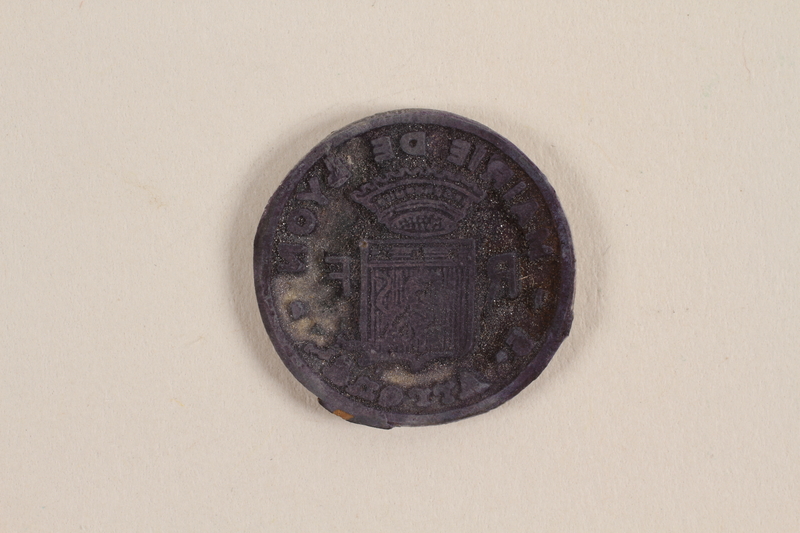Overview
- Brief Narrative
- Counterfeit unmounted hand stamp made by Gilbert Leidervarger in southern France between 1942 and 1944 to authenticate forged documents made by the French resistance. It is a town hall stamp for Lyon. Recreating official rubber stamps was difficult because of the special materials and carving skills required. Erasing rubber was not really suitable; some forgers used linoleum or sliced and combined sections from purloined or discontinued stamps. After Germany invaded France on May 10, 1940, Gilbert, wife Suzanne Donoff, and Suzanne’s six siblings, Lina, Rosette, David, Robert, two other sisters, and Robert’s wife Nelly, became involved with Eclaireurs israélites de France (Jewish Scouts of France) and its clandestine branch, La Sixieme. They worked in southern France, governed by the Vichy regime, but occupied by German troops in November 1942. Gilbert made copies of official stamps to authenticate the false papers made by Robert. Lina, Rosette, and David were in Lyon, hiding children and providing false papers and ration cards. France was liberated late summer 1944. David, Robert, and Nelly were killed for their resistance activity.
- Date
-
use:
1942-1944
- Geography
-
creation:
Vichy (France)
- Credit Line
- United States Holocaust Memorial Museum Collection, Gift of Elaine Frank, in memory of her mother, Lina Donoff Frank, and her aunts and uncles, David, Robert, and Nelly Donoff and Gilbert Leidervarger
- Markings
- stamp die, embossed : ∙MAIRIE DE LYON∙ / R F / 5. Arron(?) [Town Hall of Lyon 5th Arrondisement]
- Contributor
-
Artisan:
Gilbert Leidervarger
Subject: Gilbert Leidervarger
- Biography
-
Gilbert Leidervarger was born in 1915 in France. He married Suzanne Donoff. Suzanne was born in Paris, France, to a Jewish couple, Israel and Eva Kouklia Donoff. She had six siblings: Robert (1912-1944), Lina (1916-1978), David (1920-1944), Rosette (1921-1951), and two other sisters. Robert was married to Nelly Weyl (1911-1944). On May 10, 1940, Germany invaded France. In June, an armistice was signed and the north and west regions were placed under the control of a German military administration. The southern region was placed under the control of the Vichy Regime, which collaborated with the Germans, but was not occupied initially. Gilbert, his wife, and his wife’s six siblings may have lived in Paris at the time of the invasion. However, during the occupation, they lived in Vichy France near Moissac and Lyon.
The entire family was involved in the Eclaireurs israélites de France (EIF, Jewish Scouts of France). The EIF, established in 1923 by Robert Gamzon, initially sought to attract youth toward Judaism and away from radical political movements. In the late 1930’s, the EIF cosponsored a program with Chomerim, a Zionist scouting group, and established an agricultural training school which prepared youth to immigrate to Palestine. After the outbreak of war in September 1939 when Germany invaded Poland, it established several children’s homes in southern France. After the German invasion of France in 1940, the EIF moved to Vichy France, while continuing to operate an illegal branch in Paris. In 1941, the EIF was forced to join the Union Generale Des Israelites De France (UGIF, Union of French Jews), established by the Vichy regime to consolidate all Jewish organizations. In 1941, Gilbert’s brother-in-law David voluntarily entered Gurs internment camp to help the inmates. He smuggled children out of the camp and hid them with families in the countryside. German forces began mass deportations of Jews in spring/summer 1942. In response, the EIF formed La Sixieme (The Sixth), an underground rescue network. The primary goal of La Sixieme was to rescue children at risk for deportation. They found safe hiding places for them in schools, religious institutions, and families, provided them with false documents, either obtained from sympathetic officials or counterfeited by La Sixieme members. They also delivered supplies to the children and maintained an emotional bond with them so they did not feel abandoned. In June 1942, David left Gurs to join the armed resistance. In August, David, Lina, and Rosette helped hide and relocate children from EIF homes during German raids. On November 10, 1942, German troops occupied Vichy France. In 1943, David and Lina moved to Lyon.
Gilbert and his wife Suzanne lived in Moissac, the initial headquarters for La Sixieme. Many group members had official positons with Jewish or Catholic aid agencies. Gilbert’s false identity was Andre Flourens and his codename was Renne. La Sixieme obtained some town hall stamps needed to authenticate documents from a few town halls where there were resistance members. But they needed to expand the selection. Gilbert became an expert hand stamp forger, creating stamps used to authenticate false papers, including birth and work certificates, travel papers, and identification documents. Gilbert initially carved stamp dies out of blocks of rubber eraser, then used softer blocks of linoleum. Among the types of stamps that Gilbert counterfeited were town hall stamps and police stamps. La Sixieme selected town halls that had been destroyed by bombing in 1940. They would send a letter to the town hall asking for a copy of a birth certificate. The town hall would reply with the information that the records had been destroyed. The replies would be on paper stamped with the town hall stamp. Gilbert then copied the design onto the counterfeit stamp. Gilbert also doctored cards that they could not yet duplicate, such as ration cards. He would bleach out words such as Juif, and enter the new information.
In September 1943, La Sixieme moved its headquarters to the larger town of Lyon, and Gilbert and Suzanne moved there also. Gilbert worked morning to night as a forger for La Sixieme, as well as for M.J.S., the Zionist Youth Movement. Gilbert received orders from La Sixieme members in Paris until the operatives there were able to manufacture their own stamps. Suzanne picked up the orders, but otherwise they had very few contacts with the outside world. Gilbert produced thousands of documents. EIS and MJS supplied hundreds of thousands to refugees, those fleeing deportation, as well as resistance members and fighters. After finding homes for 400 children in October 1943, Rosette also went to Lyon. Lina and Rosette worked for David in social services. David’s official position was secretary to Abbe Glasberg of the church of St. Alban, a resistance member. They placed families in hiding and provided them with false papers and ration cards. The group manufactured over 600 sets of false papers. Robert fabricated false papers, including identity documents such as birth and baptismal certificates. In January 1944, Robert and his pregnant wife Nelly were arrested and sent to Drancy transit camp in Paris. On June 27, 1944, David was caught and shot in the street by the Gestapo in Lyon. Rosette left Lyon and went to Grenoble, which was liberated in August. Lina, Gilbert, and Suzanne stayed in Lyon, where they were liberated by American forces on September 3.
The war ended when Germany surrendered on May 7, 1945. The family learned that Robert and Nelly were deported from Drancy to Auschwitz-Birkenau concentration camp on February 3, 1944, where they were killed. Lina married an American soldier and immigrated to the United States. Rosette died of tuberculosis in 1951 in France. Gilbert and Suzanne returned to Paris, where Gilbert died sometime before 1988.
Physical Details
- Language
- French
- Classification
-
Office Equipment and Supplies
- Category
-
Marking devices
- Object Type
-
Hand stamps (lcsh)
- Physical Description
- Small, circular, nearly flat, blackened, tarnished metal stamp die with the reverse image of a crest with a crown over a shield with a lion within a raised rim. There is French text above and below. The raised text and image are stained purple and the recessed surface is gray and covered with a glittery adhesive. Remnants of gray cardboard are adhered to the back.
- Dimensions
- overall: | Depth: 0.875 inches (2.223 cm)
- Materials
- overall : metal, cardboard, adhesive, ink
Rights & Restrictions
- Conditions on Access
- No restrictions on access
- Conditions on Use
- No restrictions on use
Keywords & Subjects
- Topical Term
- False certification--France--Biography. Forgers--France--Biography. Holocaust, Jewish (1939-1945)--France--Personal narratives. World War, 1939-1945--Jewish resistance--France--Personal narratives. World War, 1939-1945--Jews--Rescue--France--Biography. World War, 1939-1945--Underground movements--France--Personal narratives.
- Geographic Name
- France--History--German occupation, 1940-1945--Biography.
Administrative Notes
- Legal Status
- Permanent Collection
- Provenance
- The stamp was donated to the United States Holocaust Memorial Museum in 1988 by Elaine Frank, the niece of Gilbert Leidervarger.
- Funding Note
- The cataloging of this artifact has been supported by a grant from the Conference on Jewish Material Claims Against Germany.
- Record last modified:
- 2022-07-28 18:11:49
- This page:
- https://collections.ushmm.org/search/catalog/irn521755
Also in Gilbert Leidervarger and Donoff family collection
The collection consists of eleven hand stamps, documents, and photographs relating to the experiences of Gilbert Leidervarger, his wife Suzanne, and his in-laws, Lina, David, Robert, Nelly, and Rosette Donoff, when they were active in forgery activities for the French resistance during the German occupation of France in World War II.
Date: 1942-1944
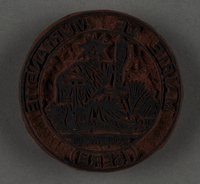
Murianette town hall stamp made to forge papers for the resistance
Object
Counterfeit unmounted hand stamp made by Gilbert Leidervarger between 1942 and 1944 to authenticate forged documents for the French resistance. It is a town hall stamp for Murianette near Grenoble in southern France. Recreating official rubber stamps was difficult because of the special materials and carving skills required. Erasing rubber was not really suitable; some forgers used linoleum or sliced and combined sections from purloined or discontinued stamps. After Germany invaded France on May 10, 1940, Gilbert, wife Suzanne Donoff, and Suzanne’s six siblings, Lina, Rosette, David, Robert, two other sisters, and Robert’s wife Nelly, became involved with Eclaireurs israélites de France (Jewish Scouts of France) and its clandestine branch, La Sixieme. They worked in southern France, governed by the Vichy regime, but occupied by German troops in November 1942. Gilbert made copies of official stamps to authenticate the false papers made by Robert. Lina, Rosette, and David were in Lyon, hiding children and providing false papers and ration cards. France was liberated late summer 1944. David, Robert, and Nelly were killed for their resistance activity.
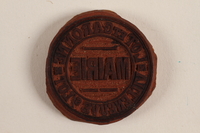
Villeneuve-sur-Lot town hall stamp made to forge papers for the resistance
Object
Counterfeit hand stamp made by Gilbert Leidervarger in southern France between 1942 and 1944 to authenticate forged documents made by the French resistance. It is a town hall stamp for Villeneuve-sur-Lot in the Lot-et-Garonne department. Recreating official rubber stamps was difficult because of the special materials and carving skills required. Erasing rubber was not really suitable; some forgers used linoleum or sliced and combined sections from purloined or discontinued stamps. After Germany invaded France on May 10, 1940, Gilbert, wife Suzanne Donoff, and Suzanne’s six siblings, Lina, Rosette, David, Robert, two other sisters, and Robert’s wife Nelly, became involved with Eclaireurs israélites de France (Jewish Scouts of France) and its clandestine branch, La Sixieme. They worked in southern France, governed by the Vichy regime, but occupied by German troops in November 1942. Gilbert made copies of official stamps to authenticate the false papers made by Robert. Lina, Rosette, and David were in Lyon, hiding children and providing false papers and ration cards. France was liberated late summer 1944. David, Robert, and Nelly were killed for their resistance activity.
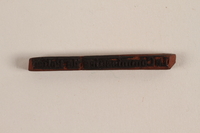
Police commissioner stamp made to forge papers for the resistance
Object
Counterfeit police commissioner hand stamp made by Gilbert Leidervarger in southern France between 1942 and 1944 to authenticate forged documents made by the French resistance. Recreating official rubber stamps was difficult because of the special materials and carving skills required. Erasing rubber was not really suitable; some forgers used linoleum or sliced and combined sections from purloined or discontinued stamps. After Germany invaded France on May 10, 1940, Gilbert, wife Suzanne Donoff, and Suzanne’s six siblings, Lina, Rosette, David, Robert, two other sisters, and Robert’s wife Nelly, became involved with Eclaireurs israélites de France (Jewish Scouts of France) and its clandestine branch, La Sixieme. They worked in southern France, governed by the Vichy regime, but occupied by German troops in November 1942. Gilbert made copies of official stamps to authenticate the false papers made by Robert. Lina, Rosette, and David were in Lyon, hiding children and providing false papers and ration cards. France was liberated late summer 1944. David, Robert, and Nelly were killed for their resistance activity.
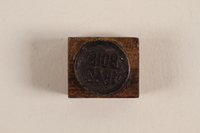
Bois 1942 hand stamp made to forge papers for the resistance
Object
Counterfeit hand stamp with Bois 1942 made by Gilbert Leidervarger in southern France between 1942 and 1944 to authenticate forged documents made by the French resistance. Recreating official rubber stamps was difficult because of the special materials and carving skills required. Erasing rubber was not really suitable; some forgers used linoleum or sliced and combined sections from purloined or discontinued stamps. After Germany invaded France on May 10, 1940, Gilbert, wife Suzanne Donoff, and Suzanne’s six siblings, Lina, Rosette, David, Robert, two other sisters, and Robert’s wife Nelly, became involved with Eclaireurs israélites de France (Jewish Scouts of France) and its clandestine branch, La Sixieme. They worked in southern France, governed by the Vichy regime, but occupied by German troops in November 1942. Gilbert made copies of official stamps to authenticate the false papers made by Robert. Lina, Rosette, and David were in Lyon, hiding children and providing false papers and ration cards. France was liberated late summer 1944. David, Robert, and Nelly were killed for their resistance activity.
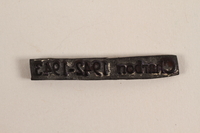
Charbon hand stamp made to forge papers for the resistance
Object
Counterfeit unmounted hand stamp with Charbon 1942-1943 made by Gilbert Leidervarger in southern France between 1942 and 1944 to authenticate forged documents made by the French resistance. The stamp likely was used to forge coal ration cards. Recreating official rubber stamps was difficult because of the special materials and carving skills required. Erasing rubber was not really suitable; some forgers used linoleum or sliced and combined sections from purloined or discontinued stamps. After Germany invaded France on May 10, 1940, Gilbert, wife Suzanne Donoff, and Suzanne’s six siblings, Lina, Rosette, David, Robert, two other sisters, and Robert’s wife Nelly, became involved with Eclaireurs israélites de France (Jewish Scouts of France) and its clandestine branch, La Sixieme. They worked in southern France, governed by the Vichy regime, but occupied by German troops in November 1942. Gilbert made copies of official stamps to authenticate the false papers made by Robert. Lina, Rosette, and David were in Lyon, hiding children and providing false papers and ration cards. France was liberated late summer 1944. David, Robert, and Nelly were killed for their resistance activity.
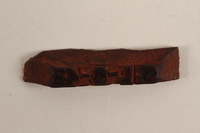
C.I.-6-43 hand stamp made to forge papers for the resistance
Object
Counterfeit hand stamp made by Gilbert Leidervarger in southern France between 1942 and 1944 to authenticate forged documents made by the French resistance. Recreating official rubber stamps was difficult because of the special materials and carving skills required. Erasing rubber was not really suitable; some forgers used linoleum or sliced and combined sections from purloined or discontinued stamps. After Germany invaded France on May 10, 1940, Gilbert, wife Suzanne Donoff, and Suzanne’s six siblings, Lina, Rosette, David, Robert, two other sisters, and Robert’s wife Nelly, became involved with Eclaireurs israélites de France (Jewish Scouts of France) and its clandestine branch, La Sixieme. They worked in southern France, governed by the Vichy regime, but occupied by German troops in November 1942. Gilbert made copies of official stamps to authenticate the false papers made by Robert. Lina, Rosette, and David were in Lyon, hiding children and providing false papers and ration cards. France was liberated late summer 1944. David, Robert, and Nelly were killed for their resistance activity.
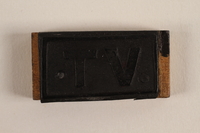
VT hand stamp made to forge papers for the resistance
Object
Counterfeit hand stamp made by Gilbert Leidervarger in southern France between 1942 and 1944 to authenticate forged documents made by the French resistance. Recreating official rubber stamps was difficult because of the special materials and carving skills required. Erasing rubber was not really suitable; some forgers used linoleum or sliced and combined sections from purloined or discontinued stamps. After Germany invaded France on May 10, 1940, Gilbert, wife Suzanne Donoff, and Suzanne’s six siblings, Lina, Rosette, David, Robert, two other sisters, and Robert’s wife Nelly, became involved with Eclaireurs israélites de France (Jewish Scouts of France) and its clandestine branch, La Sixieme. They worked in southern France, governed by the Vichy regime, but occupied by German troops in November 1942. Gilbert made copies of official stamps to authenticate the false papers made by Robert. Lina, Rosette, and David were in Lyon, hiding children and providing false papers and ration cards. France was liberated late summer 1944. David, Robert, and Nelly were killed for their resistance activity.
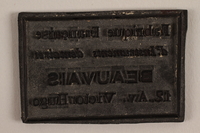
Dental company stamp made to forge papers for the resistance
Object
Counterfeit unmounted hand stamp made by Gilbert Leidervarger in southern France between 1942 and 1944 to authenticate forged documents made by the French resistance. The stamp mark is for a dental instruments company in Beauvais, probably for forging work papers. Making rubber stamps was difficult because of the special materials and carving skills required. Erasing rubber was not really suitable; some forgers used linoleum or sliced and combined sections from purloined or discontinued stamps. After Germany invaded France on May 10, 1940, Gilbert, wife Suzanne Donoff, and Suzanne’s six siblings, Lina, Rosette, David, Robert, two other sisters, and Robert’s wife Nelly, became involved with Eclaireurs israélites de France (Jewish Scouts of France) and its clandestine branch, La Sixieme. They worked in southern France, governed by the Vichy regime, but occupied by German troops in November 1942. Gilbert made copies of official stamps to authenticate the false papers made by Robert. Lina, Rosette, and David were in Lyon, hiding children and providing false papers and ration cards. France was liberated late summer 1944. David, Robert, and Nelly were killed for their resistance activity.
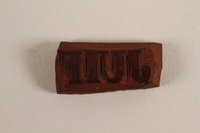
Stamp with Juif, French for Jew, made to forge papers for the resistance
Object
Counterfeit hand stamp with Juif for Jew made by Gilbert Leidervarger in southern France between 1942 and 1944 to authenticate forged documents made by the French resistance. Recreating official rubber stamps was difficult because of the special materials and carving skills required. Erasing rubber was not really suitable; some forgers used linoleum or sliced and combined sections from purloined or discontinued stamps. After Germany invaded France on May 10, 1940, Gilbert, wife Suzanne Donoff, and Suzanne’s six siblings, Lina, Rosette, David, Robert, two other sisters, and Robert’s wife Nelly, became involved with Eclaireurs israélites de France (Jewish Scouts of France) and its clandestine branch, La Sixieme. They worked in southern France, governed by the Vichy regime, but occupied by German troops in November 1942. Gilbert made copies of official stamps to authenticate the false papers made by Robert. Lina, Rosette, and David were in Lyon, hiding children and providing false papers and ration cards. France was liberated late summer 1944. David, Robert, and Nelly were killed for their resistance activity.
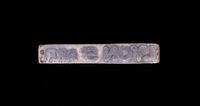
Lyon hand stamp made to forge papers for the resistance
Object
Counterfeit hand stamp with Lyon made by Gilbert Leidervarger in southern France between 1942 and 1944 to authenticate forged documents made by the French resistance. Recreating official rubber stamps was difficult because of the special materials and carving skills required. Erasing rubber was not really suitable; some forgers used linoleum or sliced and combined sections from purloined or discontinued stamps. After Germany invaded France on May 10, 1940, Gilbert, wife Suzanne Donoff, and Suzanne’s six siblings, Lina, Rosette, David, Robert, two other sisters, and Robert’s wife Nelly, became involved with Eclaireurs israélites de France (Jewish Scouts of France) and its clandestine branch, La Sixieme. They worked in southern France, governed by the Vichy regime, but occupied by German troops in November 1942. Gilbert made copies of official stamps to authenticate the false papers made by Robert. Lina, Rosette, and David were in Lyon, hiding children and providing false papers and ration cards. France was liberated late summer 1944. David, Robert, and Nelly were killed for their resistance activity.
Donoff family papers
Document
The Donoff family papers consist of biographical materials, correspondence, forged documents, photographs, and printed materials documenting the Donoff family's involvement in forgery operations for the Jewish resistance movement in France during World War II. Biographical materials include genuine identification papers for David and Lina Donoff, a pass for Lina Donoff made out in her own name and under her alias (Denise Alice Rochard), a train pass for M. Donoff, and a posthumous award of the Croix de Guerre for David Donoff. Correspondence includes a letter of thanks from Rabbi Ansbacher to David Donoff for his help at the Gurs concentration camp, a note about the death of a friend named Pierre, notes from Nelly Donoff after her arrest and before her deportation to Auschwitz, a postwar letter of commendation from Maurice Buckmaster to Lina Donoff, and letters of commendation and condolence for David Donoff. Forgery and Resistance materials include forged identification papers and signatures, examples of marks from forged rubber stamps, radio message codes, and blank forms for the creation of forged documents. Photographs depict David, Robert, and Nelly Donoff, friends of the Donoff family, the Gurs concentration camp, and a postwar ceremony honoring young members of the Resistance. Printed materials include clippings about David Donoff, the Donoff family, and other members of the French Resistance; a copy of the 1945 Libération publication Les camps d’extermination: documents, témoignages, photographies sur les camps de déportés en Allemagne; and a copy of a brochure for the Mémorial des Martyrs de la Déportation dated approximately 1962.

